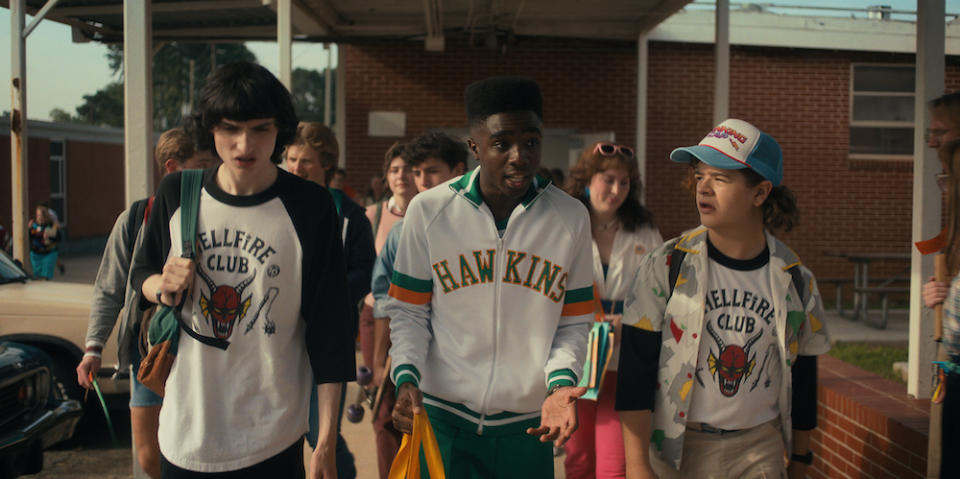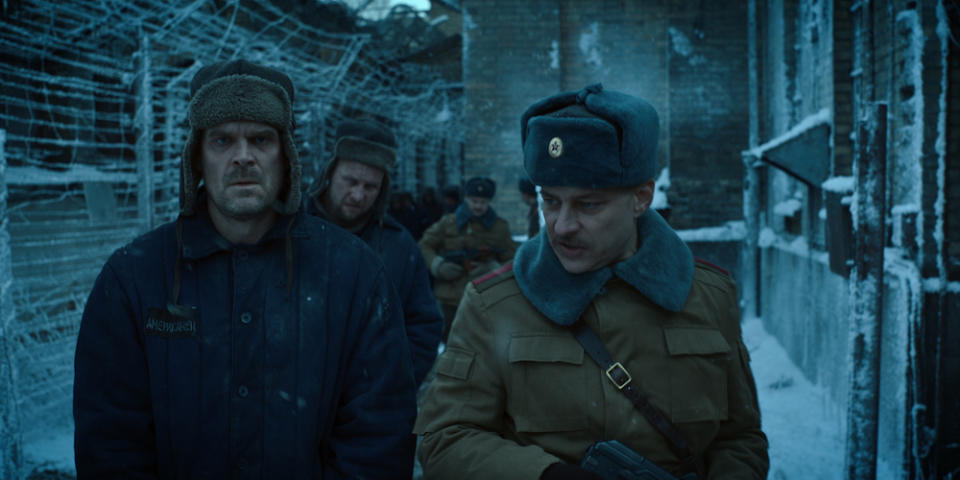‘Stranger Things 4’ Review: A Mopey, Meandering Season 4 Loses Steam Fast (No Spoilers)

Arguably, the scariest part of “Stranger Things 4” is how thoroughly it embodies the worst habits of the streaming era — with the only real competition being how much time it takes to fit them all in. Prolonged Season 4 episodes have been sold as an attribute when they’re anything but; splitting the season in two may “event-ize” Netflix’s blockbuster series, but — with only two super-sized episodes left for Part 2’s release in July — it’s no favor to fans; characters stagnate while clunky puzzle pieces are given priority; repetitive visual effects are overemphasized to mask the missing emotional impact; episodic structure is abandoned, as if co-creators Matt and Ross Duffer believe their whole show should be long movies, rather than just the feature-length final episodes.
If it seems like I’m getting ahead of myself, rest assured “Stranger Things” Season 4 starts with an infuriating custom of our current TV age: an in media res intro. The first eight minutes, which have been available online for days, are technically a flashback, but they serve the same function as all the other openers that start in the middle of a story rather than, you know, at the beginning. In trying to skip straight to the action and tease mysterious events to come, all that’s actually accomplished is extending the run time and, more significantly, undercutting the story’s natural momentum. Seeing an obviously pivotal moment right out of the gate, only to ignore it for seconds, then minutes, then hours, creates a timer in the audience’s head, ticking down until the series catches up to itself. If the wait was shorter or even adequately distracting, perhaps a teasing glimpse of what’s next could work, but “Stranger Things 4” is sluggish and — for a show built for homages to ’80s pop culture and centering a bunch of goofy kids — shockingly glum.
More from IndieWire
Without delving into spoiler territory, Season 4 often feels like it’s testing the group of no-longer-child actors to see who can successfully bridge the gap from teenage pouting to proper brooding. Eleven (Millie Bobby Brown), after moving out of Hawkins with Joyce (Winona Ryder), Jonathan (Charlie Heaton), and Will (Noah Schnapp), isn’t fitting in at her new school. Without her old crew of accepting, empathetic friends, “Jane” is ruthlessly bullied. She tries to paint a happy portrait in letters home to her beloved Mike (Finn Wolfhard), but Will — whose artistic inspiration has evolved from frantic black-and-white scribbles to painting with colors — knows the truth, and he’s as irked with Eleven’s lies as he is with Mike for forgetting about his one-time best friend.

Courtesy of Netflix
Brown isn’t given material that’s too taxing (still delivering confused glances, still frustrated over her absent powers), while Schnapp does the best he can with a rather wayward, thankless role. But it must be said: The actors have aged out of their parts, and it’s distracting. “Stranger Things” spans three years between Seasons 1 and 4 (1983 – 1986); the actors aged six years during that same window — which may not sound like a lot, until you remember how much people change from ages ~12 to 18. Convincing viewers they’re still 14-year-old kids may have been easier if the episodes allowed for the kind of levity, awkwardness, and exuberance associated with mischievous, hormonal youths. Instead, in the series’ ongoing bid to be taken far too seriously, they’re written more like the adults (and almost-adults) they are, resulting in rough exchanges between shared crushes as they strive for depth that isn’t there and super weird speeches from the basketball team’s captain (Mason Dye, age 27) as he morphs into an Evangelical preacher when handed a microphone.
Getting back to the “Why so sullen?” question — which permeates Season 4 from the strained performances, to the heavy-handed length, to the chosen focus — some anguish is unavoidable. Max (Sadie Sink) is mourning the loss of her brother, Billy (Dacre Montgomery). Yes, sure, that’s fine. Also passable: Nancy (Natalia Dyer) and Jonathan kinda, sorta miss each other (or at least let the other’s absence bum them out). And Joyce still believes Hopper (David Harbour) is dead. Beyond that perfectly legitimate bummer, her new job, selling encyclopedias over the phone, doesn’t offer much camaraderie, and even when she considers the possibility that Hawkins’ local sheriff is still out there, it’s a long journey toward believing it.
Hopper — still very much alive, as shown in Season 3’s closing tease and confirmed in Netflix marketing — leans hard into unhappiness. Stuck in a Russian prison after his heroic efforts to close the otherworldly gate opened by Soviet scientists, he’s now being tortured by those same sadistic baddies. But rather than thanking his lucky stars for surviving, or finding hope in his nascent romance with Joyce or parenting of Eleven, Hopper gets depressed. His arc employs some the season’s most obvious wheel-spinning, a point that may depress audiences, as well — especially since, in seasons prior, Harbour has been a somewhat reliable source of surly laughs, like a grumpy Harrison Ford with an extra dose of self-loathing.

Courtesy of Netflix
Missed opportunities for invigorating excitement extend to the core group, too. Lucas (Caleb McLaughlin) is torn between hanging with the cool kids on the basketball team or retreating with his old, nerdy friends Dustin (Gaten Matarazzo) and Mike. There are a few familiar joys to be had in Matarazzo’s cheeky asides and the affable nonchalance Maya Hawke gives Robin, but for as evident as it is the actors have grown, their characters are plainly dormant. Through seven episodes, multiple individual plots start up only to be abandoned without reason. (Robin and Lucas get the shortest end of the proverbial stick.) Other choices are forced, seemingly for the sake of convenience. (Romance has never been the series’ strong point, but it’s absurd in Season 4.) Even if these issues are addressed in the final few hours, their potential has already lapsed, in a testament to how thin the season’s many, many subplots can be.
“Stranger Things 4” puts all its chips on spectacle, Easter eggs, and fairly predictable twists. Aside from the premiere entry (which, after that detrimental introduction, is mostly a welcome throwback), the 100-minute seventh episode offers the best performance (from a character not-to-be-named) and most compelling scenes. But by no means is it a reasonable stopping point. The numbing duration combined with that in media res opening go a long way toward undermining its force, and viewers could nearly skip Episodes 2 through 6 altogether without feeling lost in Part 1’s finale.
At a time when Netflix is facing more questions than ever over sustainability, “Stranger Things 4” will likely provide a temporary security blanket. All those minutes of content driving an established blockbuster should give the company ample bragging opportunities in terms of viewer metrics and minutes watched. But along with the streamer’s general direction these days, Season 4 feels like it’s been designed to produce good data rather than quality entertainment. The algorithm once heralded for so much of Netflix’s success and derided for ignoring the human factor certainly feels present here, as any remaining strangeness gets usurped by formula.
Grade: C-
“Stranger Things” Season 4, Part 1 premieres Friday, May 27 at 3 a.m. ET on Netflix. Part 1 consists of Episodes 1-7. Episodes 8 and 9 will be released July 1.
Best of IndieWire
Sign up for Indiewire's Newsletter. For the latest news, follow us on Facebook, Twitter, and Instagram.